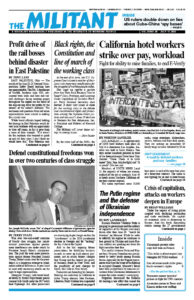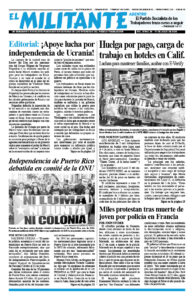EAST PALESTINE, Ohio — The results of the June 22-23 National Transportation Safety Board hearings here are unmistakable. The Feb. 3 derailment of Norfolk Southern train 32N, subsequent toxic leaks and fires and current challenges facing working people throughout the region are the result of the dog-eat-dog drive for profits by the owners of the nation’s railroads. The testimony and questions from rail union representatives were crucial in making this crystal clear.
While board officials hoped holding the hearing in East Palestine would divert local residents with an opportunity to blow off steam, in fact it gave them a sense of their strength. “If it wasn’t for the residents who wanted to speak up and tell their story, I don’t think we would have this,” East Palestine resident Russell Murphy told the Pittsburgh Post-Gazette. “It is almost unprecedented that they come to a small town or a village and hold a hearing.”
“I really don’t want to call it an accident,” Kelly Lundt told the Post-Gazette. “It was negligence.”
Four unions participated in the hearings — the Brotherhood of Locomotive Engineers and Trainmen; Sheet Metal, Air, Rail and Transportation Workers — Transportation Division; Brotherhood of Railroad Signalmen; and the Transportation Communications Union/IAM (which represents car inspectors), with union officers serving both as witnesses and questioning other witnesses throughout.
SMART-TD reported on the hearings on its website, highlighting some of the railroad’s self-serving responses to the derailment. This includes the fact that the rail bosses didn’t provide the consist of train cars and their contents — which included toxic and hazardous cargos — to the fire chief and others responsible for deciding how to deal with the jumble of burning cars on the ground. Repeated calls to Norfolk Southern’s Atlanta headquarters got no results. In the hearing, NTSB Chair Jennifer Homendy revealed Norfolk Southern had emailed the train information to one of its contractors within 12 minutes after the derailment, yet it took over an hour and much more for some agencies to get the same information to others there.
The crew of 32N was parked one mile from the derailment, as their emergency response guide instructed. “As the employee in charge of the train consist, 32N’s conductor had all the information necessary to determine the correct course of action,” the union said, “as well as all the contact information needed to get a hold of the shippers and manufacturers of the chemicals.” But the company never put the crew in contact with the townspeople.
The SMART article also explains how testimony at the hearing showed Norfolk Southern bosses ramrodded the decision to “vent and burn” five cars containing toxic vinyl chloride. They argued that one of the cars was heating up and likely to explode. They gave East Palestine Fire Chief Keith Drabick 13 minutes to decide.
In fact, as a large graph at the hearing showed, the temperature in the suspect car was going down. Officials from Oxy Vinyls, the Texas company that made the chemical and packed 700,000 pounds of it into the cars, testified they contacted Norfolk Southern to say there was virtually no danger of an explosion. For that, oxygen would have to be getting into the cars, which wasn’t happening. They advised them not to do a burn. This information was never communicated to the fire chief.
SMART safety official Jared Cassity asked Norfolk Southern contractors if they could have called off the burn in light of the falling temperature in the cars. They admitted they could have. All this was news to area residents, including Chief Drabick.
Under pressure, Drabick had allowed the contractors to proceed. The vinyl chloride was drained into a ditch and set on fire, sending toxic chemicals into the air, area streams and the soil. Any other solution, the SMART article said, “would have been inconvenient to the goal of moving freight” as soon as possible.
And that’s what the rail bosses did. They “got the trains going faster,” SMART said, “while leaving a black cloud over East Palestine.”
Within hours after the burn-off, area residents began seeing thousands of dead fish in area streams, sick pets and family members getting ill. Residents cried bloody murder.
Their public outcry was the only thing that forced Norfolk Southern to rip up the new tracks they’d laid and begin what became five months of digging up and carting away tens of thousands of tons of contaminated soil and water. Even then, they made sure one track was always open, running trains and earning profits.
Bosses shut down train inspections
Jason Cox, national representative of the Transportation Communications Union Carmen Division, told the hearing that train 32N never got an inspection by a qualified Norfolk Southern carman on route that day, even though it passed three rail yards where they were working.
Norfolk Southern has slashed the numbers of inspectors as part of its drive to cut crews and boost profits. And they’ve cut the time for inspecting a car from several minutes to one or less.
The NTSB reported that when the cars on the train were inspected after the derailment, 20 were found to have defects. “It’s my understanding that those defects were found visually by the Federal Railroad Administration after the disaster,” Cox said, meaning they would have been easily seen by carmen.
In the final session of the hearing on “Rail Tank Car Safety” it was reported the tankers holding vinyl chloride were newer, stronger cars that weren’t breached during the derailment.
But five standard tankers, designated as DOT-111 cars, derailed and did break open. These are the same kinds of cars that derailed and exploded in Lac-Mégantic in 2013, killing 47 people and destroying the town’s downtown.
The NTSB reported these cars spilled three chemical loads, including 30,000 gallons of butyl acrylate. All three chemicals are dangerous, but butyl acrylate is particularly dangerous, with acute toxicity to the respiratory system. It’s also a deadly threat to fish and all aquatic animals.
Randy Keltz, manager of Tank Car Safety Programs for the Federal Railroad Administration, said they would like to see these cars phased out, but the rail companies are resisting. He said they saw them as “50-year assets” and they want to get their money’s worth and “we have to weigh the costs and benefits.”
For workers control over railroads
Norfolk Southern CEO Alan Shaw tried to do damage control even before the hearing, telling The Associated Press June 21 that the company is looking to work with the unions to improve safety. “That interaction and that engagement with our craft colleagues is really important to me,” he claimed.
“Mr. Shaw comes across to me as kind of that used car salesman trying really hard to sell Norfolk Southern and saying all this great stuff,” replied James Orwan, TCU general chairman on Norfolk Southern.
Shaw told AP that Norfolk Southern has hired a nuclear power expert to advise on its “safety culture.” Eddie Hall, president of the Brotherhood of Locomotive Engineers and Trainmen, had the answer for that — “Hiring outside consultants may sound good to investors, but the experts are working every day in the cab of the engine.”
This is the bottom line. The answer to rail “safety culture” is for rail workers to use their unions to take control over the operations of the railroad. All the bosses’ business secrets and real financial records need to be forced out into the public.
Workers can assure trains are limited to 50 cars, with a crew of four — two on the head end and two on the rear.


